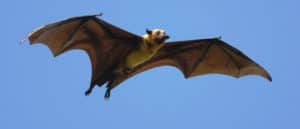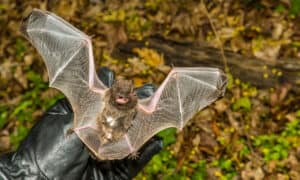If you were asked to name a spooky animal, bats would likely be near the top of the list! But what makes bats so spooky? Is it because they come out at night, and have sharp fangs and big beady eyes? Yeah, that’s a start! But should we be afraid of bats? What about vampire bats? Do they really drink our blood? Let’s find out what bats really eat!
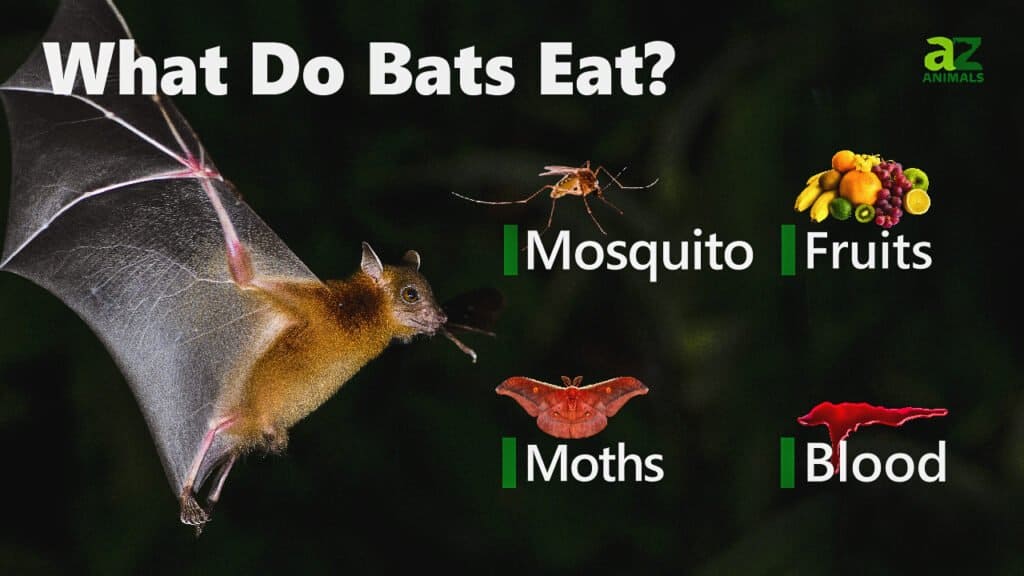
What Kinds of Bats Are There?
Microbats
Microbats are small bats, about the size of your hand that live in caves, hollowed-out trees, and buildings. This is the most common kind of bat and they can be found all over the world except for the colder regions at the poles.
Megabats
Megabats are typically larger than microbats and live in the tropics. Fruit bats are one kind of megabat. They live in Africa, Europe, Australia, and Asia and can be found in dense forests.
Vampire bats
Vampire bats are actually a species of microbats but are very different than any other type of bat. Unlike any other bat, they live off blood for both food and water. They can also run, walk, and jump which they use to hop on potential prey. They are only located in Mexico, South and Central America.
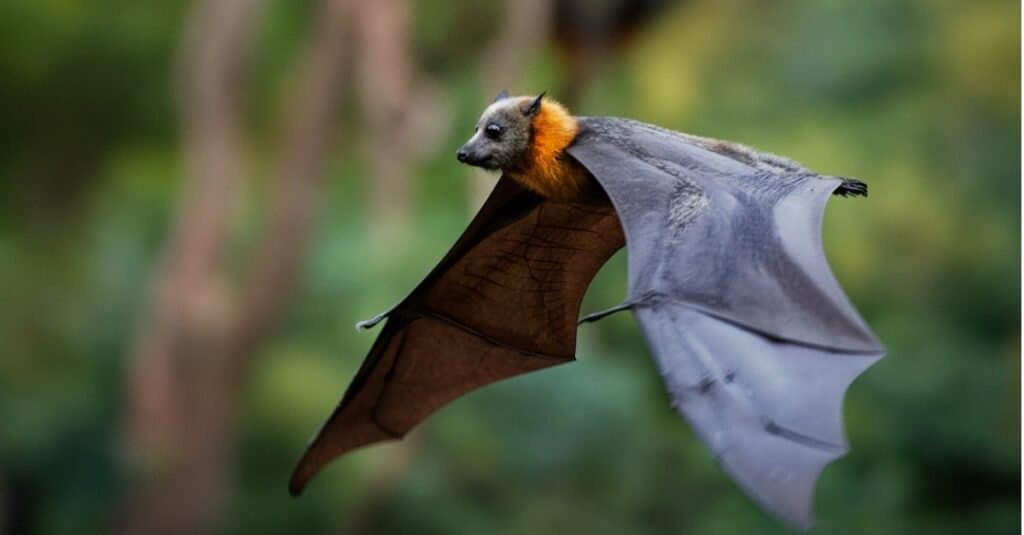
Microbats, megabats, and vampire bats all have very different means of hunting.
©iStock.com/phototrip
How Do Bats Hunt For Food?
Microbats use echolocation to find their food. They come out at night and fly through the air emitting high-pitched sounds that bounce off of insects and bounce back to the bat so they can locate it. They can fly around for hours at a time collecting insects from the air.
Megabats do not use echolocation; instead, they have an amazing sense of smell and can locate food. Research has shown that some bats, like the spear-nosed bat, will forage for fruit together to help increase the odds of finding food sources. They found that the bats would alert other bats when they had found food and follow each other to the food source.
Vampire bats come out at night to look for food and they also use echolocation, but they are not looking for mosquitos and moths. Vampire bats live off blood from animals like horses, cows, pigs, and birds. They do not savagely attack their prey like we may think; many times the host does not even know they are there. They may land on a sleeping cow, make a small incision that the cow can’t feel, and drink the blood, lapping it up like a kitten, not sucking the blood. Vampire bats have a heat-sensing nose that can help them locate the best place on an animal to find access to their blood. They can walk or run using their legs, thumbs, and wrists to sneak up on an animal as well!
What Do Bats Eat?
Microbats, such as the little brown bat and the Northern long-eared bat, fly around eating insects. They eat mosquitos, moths, crickets, chinch bugs, and beetles.
Megabats including the fruit bat and flying foxes live mostly on fruit. They may eat figs, bananas, guava, or papaya. Some megabats also eat pollen and nectar.
Vampire bats live solely on the blood of other animals. They rely on all of their nutrients from blood. They also have very little fat reserve so they cannot go more than a couple days without eating or they will die.
There are around nine bat species that are carnivores and their diet consists of meat, eaten year-round or seasonal.
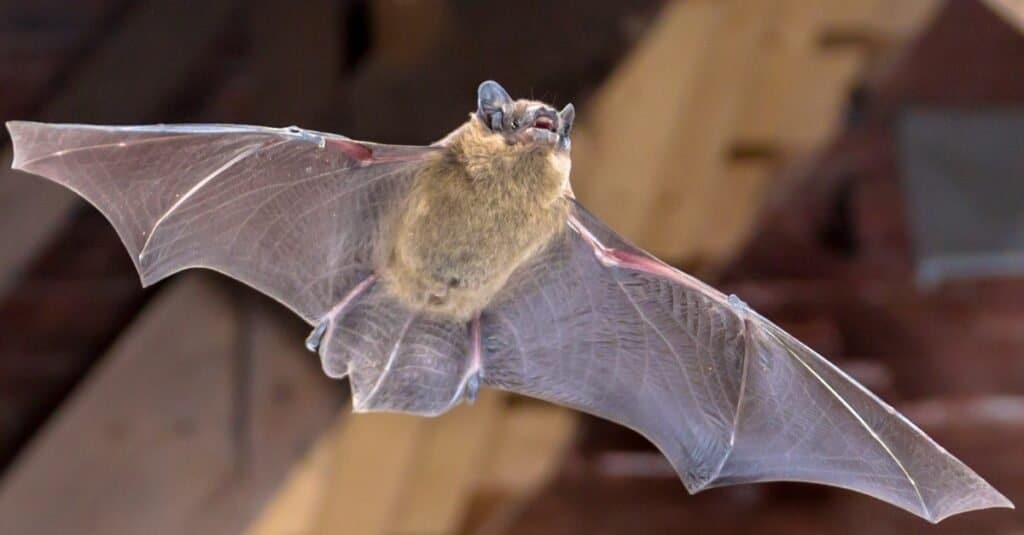
Microbats such as the common pipistrelle eat mosquitos, moths, crickets, chinch bugs, and beetles.
©Rudmer Zwerver/Shutterstock.com
Do Bats Eat Mice?
Carnivorous bat species hunt and eat rodents such as mice.
They also consume frogs, fish, lizards, birds, and other bats. Some of these bats are able to catch birds mid-flight, while others are skilled at grabbing fish on the water’s surface. Carnivorous bats have also been observed to wait and ambush prey from the ground.
Some members of the Megadermatidae family of bats, commonly known as false vampire bats, eat insects and small vertebrates. These include the lesser false vampire bat, heart-nosed bat, ghost bat, and greater false vampire bat. These last three are also one of the very few bats in the world that eat other bats.
The greater false vampire bat, also known as the spectral bat, is the biggest of the carnivorous bat species. Found in Mexico and Central and South America, its wingspan can reach more than 3 feet. It eats rodents, birds, and other bat species, and is believed to be monogamous for life.
Researchers have found that carnivorous bats are often bigger than insectivorous bats, and have longer snouts that may assist them in hunting larger prey and allow them to close their jaws at a faster speed. All carnivorous bat species are osteophagous, meaning they are able to eat the bones of their prey. Scientists are currently unsure how and why these bats adapted to eating meat.
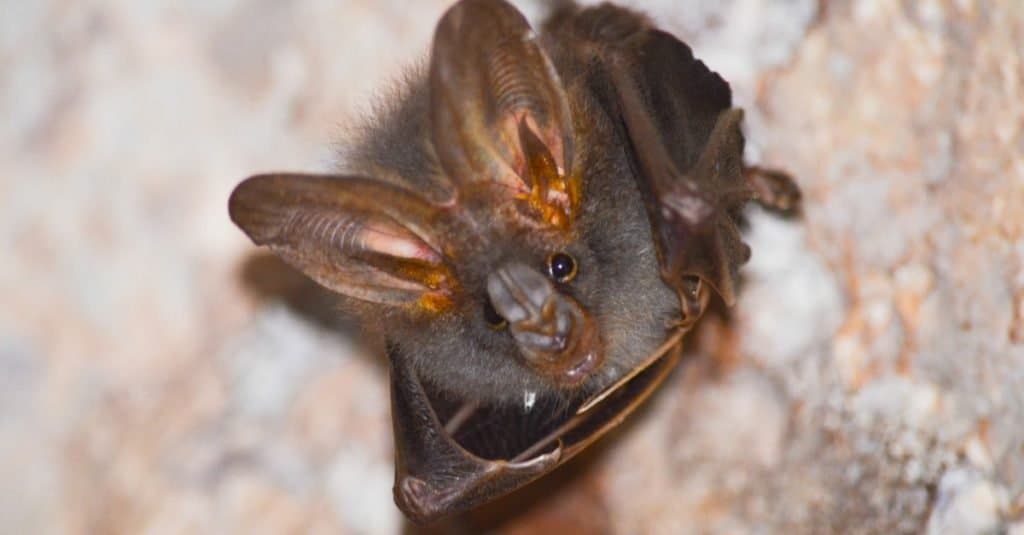
Ghost bats are carnivorous and their diet includes mice and other bat species.
©Visanuwit thongon/Shutterstock.com
Do Bats Have Teeth?
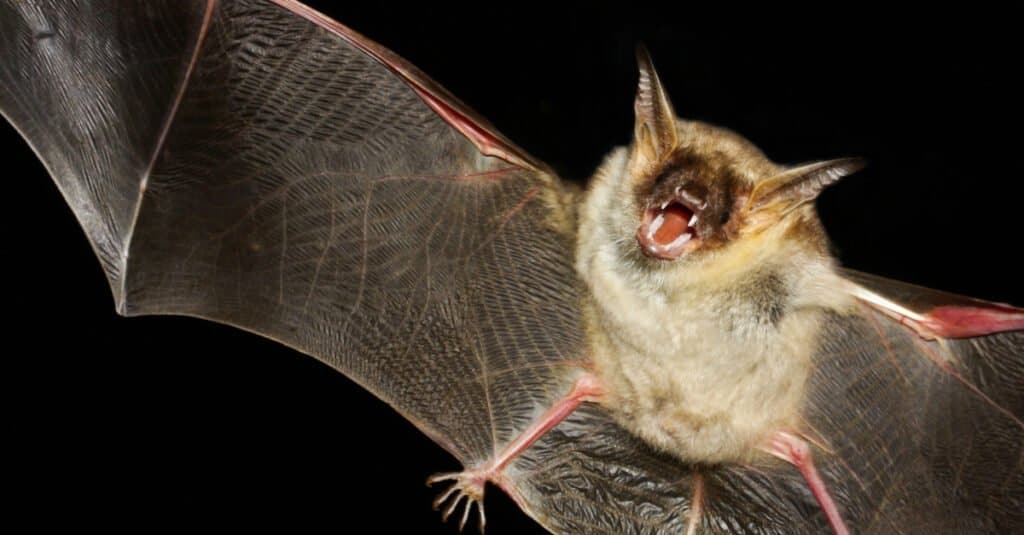
All bats have canine teeth, known as fangs, regardless of their diets.
©Geza Farkas/Shutterstock.com
Most North American bats are insectivorous and will grab their prey using their mouths. They will then incapacitate their prey by taking a small bite and then, using their tails and wings, will envelop them for consumption. Like all bats, they have teeth that are customized to their needs. These teeth are comprised of different types – incisors, canines, and molars and premolars.
The amount of teeth they have can range from 20 to 28, depending on the species. Regardless of their diet, all species of bats have canine teeth that are known as fangs, and all of their teeth are the same kind, no matter how large or small the bat is. Each set of teeth is used for something different, from chewing and biting, to grinding, and they will use them to crush their food up into tiny, digestible pieces.
A Complete List of What Bats Eat:
- Mosquitos
- Moths
- Insects
- Crickets
- Beetles
- Chinch bugs
- Fruit
- Figs
- Bananas
- Guava
- Papaya
- Nectar
- Pollen
- Blood (Vampire bats only)
- Mice
- Frogs
- Fish
- Lizards
- Birds
- Other bats.
Do Bats Eat Upside-Down?
Bats will eat food upside down, but there’s a larger reason bats are so often found hanging upside down.
First off as they are out of reach of many predators, they can easily fly away from this position if need be and it is relaxing. Their claws actually latch on and don’t require energy to hold that position and because they are small their hearts are able to pump the blood throughout their bodies without all the blood rushing to their heads. This is also the position that some bats hibernate in. Finally, there’s the simple fact that, unlike birds, bats have trouble launching themselves into the air. By dropping from branches upside down, bats are able to fly without needing to take off from the ground.
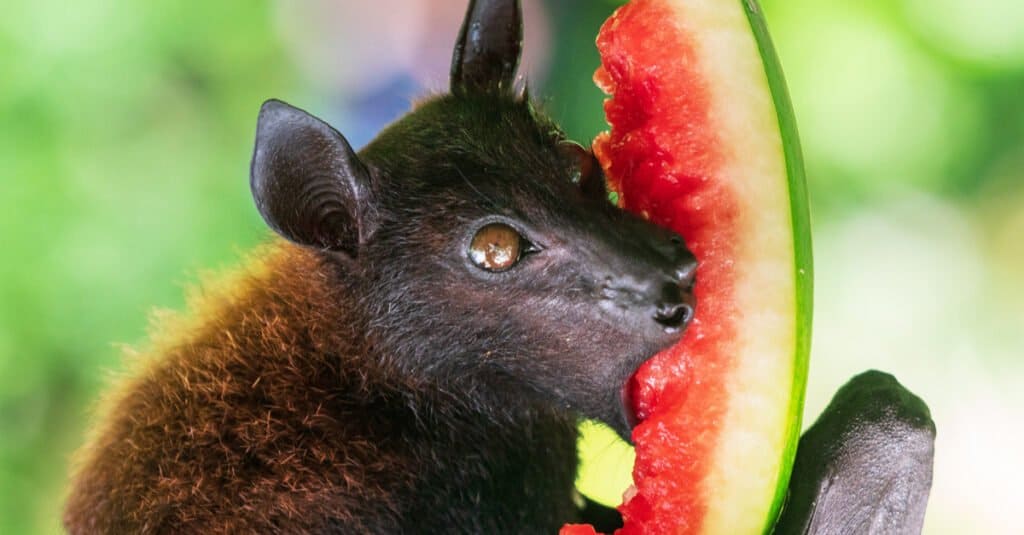
Bats can eat their food hanging upside-down if needed.
©Anton Watman/Shutterstock.com
Are Bats Dangerous to Humans?
The biggest threat to humans is not having a vampire bat suck your blood (they don’t suck remember). It is very rare for a human to be bitten by a vampire bat. The biggest threat to humans is that some bats carry rabies, a viral disease that can be fatal. Other animals like raccoons, foxes, and coyotes can carry rabies as well as pets like cats and dogs, but most pets have received vaccinations for rabies so it is rarely spread from a domestic animal bite. If you have been bitten by a bat it is advisable to seek immediate medical attention.
Summary of What Bats Eat
Here’s a recap of the foods that all types of bats eat.
| Number | Food |
|---|---|
| 1 | Mosquitos |
| 2 | Moths |
| 3 | Insects |
| 4 | Crickets |
| 5 | Beetles |
| 6 | Chinch bugs |
| 7 | Fruit |
| 8 | Figs |
| 9 | Bananas |
| 10 | Guava |
| 11 | Papaya |
| 12 | Nectar |
| 13 | Pollen |
| 14 | Blood (Vampire bats only) |
| 15 | Mice |
| 16 | Frogs |
| 17 | Fish |
| 18 | Lizards |
| 19 | Birds |
| 20 | Other bats |
The photo featured at the top of this post is © Anton Watman/Shutterstock.com
Thank you for reading! Have some feedback for us? Contact the AZ Animals editorial team.



